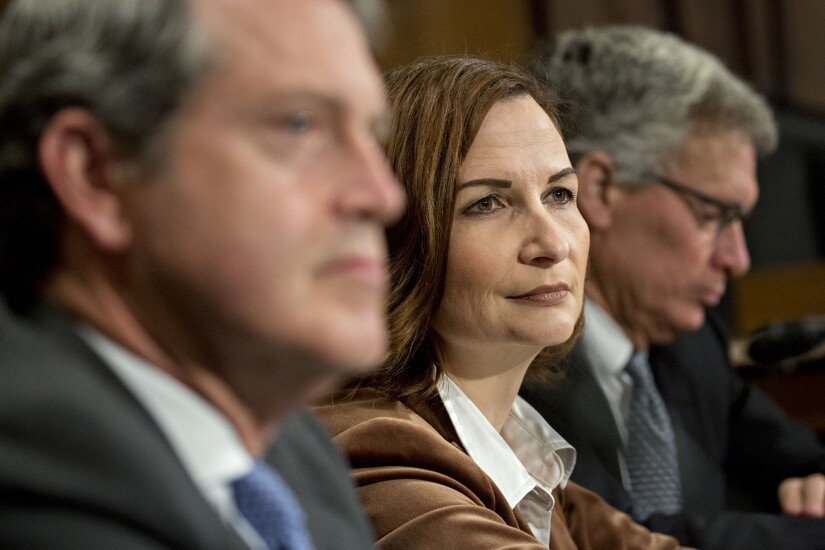There is a surprising amount of pessimism in the air among bankers, including fears of another recession and resurgent House Democratic activism against the industry. But there are also lots of reasons financial institutions should be feeling grateful. Following is a detailed look at a few:
The 'blue wave' didn't swamp the Senate
But many bankers are relieved that Republicans have maintained their control of the Senate, as well as the White House. That means that while there could be a slew of negative headlines for the industry emerging from the House, that's unlikely to translate into broad legislative wins. The divided government is likely to limit any significant efforts by House Democrats to impose tougher standards on the industry, with the banking agencies expected to drive the majority of regulatory changes. That's not so bad for the financial sector, all told, especially after the passage of sweeping regulatory relief this spring.

Tax reform — the gift that keeps on giving
The corporate tax rate was cut to 21% from 35% in December. It was a big reason why banks’ profits soared this year. The industry’s total profit in the third quarter
A quick look at taxes shows why.
Total income taxes paid by all banks fell 25% to $16.3 billion in the third quarter from a year earlier, according to FDIC call report figures compiled by BankRegData.com.
The average income tax rate for banks dropped 1,056 basis points to 20.85% in the same period.
“Lower taxes and higher interest rates [have] significantly enhanced our return and profitability profile,” BJ Losch, chief financial officer of the $40 billion-asset First Horizon National in Memphis, Tenn., said in an April conference call.
The tax cut wasn’t just helpful to shareholders. Many banks used the federal tax cut to
While the tax cut was a nice boost for 2018, many investors may start asking “What have you done for me lately?” in 2019. If lower taxes are the primary driver of profit growth again next year, and commercial loan demand remains soft and deposit costs continue to climb, investors might lose their enthusiasm for the sector.
Then again, 2018 has been a
Perhaps bank executives should also be thankful for the sector’s decline in the stock market. Bank stocks in 2019 arguably have nowhere to go but up.

They have a friendly interest rate environment
The average net interest margin rose 15 basis points to 3.45% in the third quarter, according to
The $71 billion-asset Comerica in Dallas, for example,
Rising interest income also helped to offset
Until now, many banks have kept deposit costs at bay, too. The FDIC said that on average, asset yields increased by 44 basis points from last year, outpacing a 29-basis-point increase in funding costs.
To be sure, this situation can’t last forever, and as the Federal Reserve continues to raise rates, banks will inevitably have to start paying up for deposits. Some regional banks

Consumers are spending a lot — and managing their debts
After paying off debt following the financial crisis, consumers have grown more comfortable with leverage. Household debt — a category that mortgages, student loans, car loans and credit cards — soared to a record $13.5 billion as of Sept. 30,
But credit quality has remained strong. Sure, delinquencies in
“It feels to me that the economy is in a really good space,” JPMorgan Chase’s Gordon Smith, who is co-president, co-chief operating officer and CEO of the consumer and community bank, said
Smith pointed to the strength of the U.S. job market, noting that the unemployment rate recently hit its lowest level point since 1969. Consumers are simply more likely to stay current on their loans if they have a steady income.
Still, for those consumers who are binging on debt — and for the banks that are lending them money — there will likely be consequences down the road.
Consider the warning signs sent by Discover Financial Services’ recent move to pull back on personal loans. In a
“It’s very tricky to underwrite, because you get one decision,”
Responding to the Fed’s latest report on household debt, Moody’s took a notably pessimistic view. While the average delinquency rate on household debt has remained steady over the past year, fluctuating between 4.52% and 4.67%, the credit rating firm said it expects that figure to increase in the months ahead.
“We believe delinquencies are now above their cycle low and that the effects of gradually loosening underwriting standards as well as rising interest rates will begin to weigh on loan performance in the coming quarters,” Moody’s said in a recent note to clients.

All but one of the Trump administration's regulators are now in place
And though Mick Mulvaney has been running the Consumer Financial Protection Bureau in an acting capacity for the past year, a permanent replacement will be at the helm very soon. Kathy Kraninger, Trump's pick for the CFPB, is expected to be approved by the full Senate when it returns from recess for its final session of the year.
Meanwhile, the final chief regulator of the Obama administration is almost out the door. Mel Watt's term as director of the Federal Housing Finance Agency is due to expire in January. Trump has yet to name a successor, and speculation has ranged from outgoing House Financial Services Committee Chairman Jeb Hensarling to retiring Sen. Bob Corker, R-Tenn., to Mark Calabria, the chief economist for Vice President Mike Pence.
Whatever the choice is, the Trump administration will have final control of all the banking and housing regulators early in the new year.
Whether that's quite the boon that banks expected initially after Trump's win is unclear. So far, the banking industry has been disappointed by regulatory proposals to

Regulators are opening their arms for de novos
Industry watchers cite an improved economy, industry consolidation, tax reform and a friendlier regulatory environment as factors. The FDIC has approved 10 de novo bank applications for insurance in 2018, up from eight approvals in 2017 and two in 2016.
The agency has received 21 de novo insurance applications this year and five new banks have so far opened their doors, as of Sept. 30.
“From a bank regulatory perspective, the environment for de novo charters is the best it’s been in decades,” David Freeman, who oversees Arnold & Porter's financial services practice, said in an interview earlier this year.
Regulators have approved de novo efforts in Massachusetts, New York, Florida, Oklahoma, Tennessee, Alabama, Nevada and Michigan. There are also several groups in states including North Carolina, Georgia and Arizona that are in the early stages of planning new banks.
Many of the de novo banks currently in the works have carved out niches in business banking, the innovation economy and military veterans. Most of the groups have also recruited experienced CEOs who have started a bank or two before, said Lee Bradley, senior managing director at Community Capital Advisors.
Still, organizing groups and de novo consultants have complained that starting a new bank is a long, meticulous process. The process is particularly challenging for groups trying to disrupt the traditional banking model.
Jelena McWilliams, the new FDIC chief, has indicated that the agency will make changes to speed up the process.
“In order for us to replenish the ranks of the specialty community banks, we need to encourage de novo application,” McWilliams said before the Senate Banking Committee in October.
The FDIC aims to approve de novo bank applications in 120 days, according to the agency’s website.






